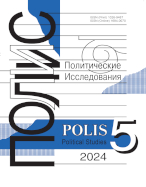Political and ecological aspects of the food miles concept
Malov A.V.,
Russian State University for the Humanities, Moscow, Russia, malov.pvo@gmail.com
elibrary_id: 924411 | ORCID: 0000-0002-6493-5150 | RESEARCHER_ID: F-2545-2018
Article received: 2023.04.24. Accepted: 2023.08.18

DOI: 10.17976/jpps/2024.01.07
EDN: LZDEYJ
Malov A.V. Political and ecological aspects of the food miles concept. – Polis. Political Studies. 2024. No. 1. https://doi.org/10.17976/jpps/2024.01.07. EDN: LZDEYJ (In Russ.)
The corpus of political science problems related to the development, security, and sovereignty of the state, which stimulates the increased interest of both government structures and representatives of the scientific community, also includes a new concept of ‘food miles.’ The deconstruction method and comparative analysis applied by the author showed that the semantic foundation of the terminological unit under consideration is based on the neorealist paradigm of international relations. The author seeks not only to highlight the epistemological gaps of the concept, but also to convert them into competitive advantages, thus contributing to the discourse related to the construction of ‘improved food miles.’ In the empirical part of the research, the author chose the agricultural policy of the Moscow region as an example, in particular, fixing the low food self-sufficiency of the region, compensated both by the intra-national commodity movement and the import of basic foodstuffs. For the first time, the dependence on the intensive import of foreign food products into the subject of the Russian Federation was compared with the degree of environmental damage identified using mathematical methods. The author concludes that the concept of ‘food miles,’ having replenished the categorical and conceptual apparatus of political science and the theory of international relations, can be used as a mechanism of ‘green protectionism,’ activating the protection of national interests and stimulating the diversification of domestic agroecological production. As a recommendation to state bodies, the author offers a plan of amendments to legislative acts, as well as a graphic project of ecological labeling of food products.
References
Aliotte, J.T.B., Lima, D.M., & Oliveira, A.L.R. (2020). Food miles’ contribution to papaya transport logistics: from the field to the warehouse. Revista S&G, 15(2), 131-142. https://doi.org/10.20985/1980-5160.2020.v15n2.1646
Ayres, R.U., & Simonis, U.E. (1994). Industrial metabolism: restructuring for sustainable development. Hong Kong: Permanent Typesetting and Printing Co.
Ballingall, J., & Winchester, N. (2008). Food miles: starving the poor? Economics discussion papers series No. 812. Department of Economics, University of Otago. https://doi.org/10.1111/j.1467-9701.2010.01270.x
Ballingall, J., & Winchester, N. (2010). Food miles: starving the poor? The World Economy, 33(10), 1201-1217. https://doi.org/10.1111/j.1467-9701.2010.01270.x
Beer, S., & Lemmer, C. (2011). A critical review of “green” procurement. Worldwide Hospitality and Tourism Themes, 3(3), 229-244. https://doi.org/10.1108/17554211111142194
Born, B., & Purcell, M. (2006). Avoiding the local trap: scale and food systems in planning research. Journal of Planning Education and Research, 26(2), 195-207. https://doi.org/10.1177/0739456X06291389
Brown, S.L., & Pilz, U.F. (1969). U.S. agriculture: potential vulnerabilities. Menlo Park, CA: Stanford Research Institute.
Cairns, S. (2005). Delivering supermarket shopping: more or less traffic? Transport Reviews, 25(1), 51-84. https://doi.org/10.1080/0144164042000218391
Carlsson-Kanyama, A. (1997). Weighted average source points and distances for consumption origin-tools for environmental impact analysis. Ecological Economics, 23(1), 15-23. https://doi.org/10.1016/ S0921-8009(97)00566-1
Chi, K.R., MacGregor, J. & King, R. (2009). Fair miles: recharting the food miles map. GB: Oxfam UK. Coote, B. (1992). The trade trap: poverty and the global commodity markets. Oxford: Oxfam Print Unit.
Coley, D., Howard, M., & Winter, M. (2009). Local food, food miles and carbon emissions: a comparison of farm shop and mass distribution approaches. Food Policy, 34(2), 150-155. https://doi.org/10.1016/j.foodpol.2008.11.001
Collins, A., Flynn, A., Wiedmann, T., & Barrett, J. (2006). The environmental impacts of consumption at a subnational level. Journal of Industrial Ecology, 10(3), 9-24. https://doi.org/10.1162/jiec.2006.10.3.9
Crippa, M. et al. (2022). CO2 emissions of all world countries, EUR 31182 EN, JRC/IEA/PBL 2022
Report. Luxembourg: Publications Office of the European Union. Fitzgerald, K.J. (2015). Thinking globally, acting locally: locavorism and humanist sociology. https://doi.org/10.2760/07904
Humanity & Society, 40(1), 3-21. https://doi.org/10.1177/0160597615619273
Foster, J. (1999). Marx’s theory of metabolic rift: classical foundations for environmental sociology. American Journal of Sociology, 105(2), 366-405. https://doi.org/10.1086/210315
Heerwagen, R.L. et al. (2014). Can increased organic consumption mitigate climate changes? British Food Journal, 116(8), 1314-1329. https://doi.org/10.1108/BFJ-02-2013-0049
Heyes, J.A., & Smith, A. (2008). ‘Could food miles become a non-tariff barrier? SHS Acta Horticulturae, 768, 431-436. https://doi.org/10.17660/ActaHortic.2008.768.56
Hill, H. (2008). Food miles: background and marketing. ATTRA: National Sustainable Agriculture Information Service US. https://attra.ncat.org/wp-content/uploads/2019/05/foodmiles.pdf
Holt-Giménez, E., Shattuck, A., Altieri, M., Herren, H. & Gliessman, S. (2012). We already grow enough food for 10 billion people... and still can’t end hunger. Journal of Sustainable Agriculture, 36(6), 595-598. https://doi.org/10.1080/10440046.2012.695331
Jones, A. (2002). An environmental assessment of food supply chains: a case study on dessert apples. Environmental Management 30(4), 560-576. https://doi.org/10.1007/s00267-002-2383-6
Kemp, K. et al. (2010). Food miles: do UK consumers actually care? Food Policy, 35(6), 504-513. https://doi.org/10.1016/j.foodpol.2010.05.011
Kingsolver, B. (2007). Animal, vegetable, miracle: a year of food life. New York: Harper Collins.
Kooijman, J.M. (1993). Environmental assessment of packaging: sense and sensibility. Environmental Management, 17(5), 575-586. https://doi.org/10.1007/BF02393720
Suh, K-W. (2012). An analysis of food miles and CO2 emission of major agricultural products. Journal of Korean Society for Atmospheric Environment, 28(6), 706-713. http://dx.doi.org/10.5572/KOSAE.2012.28.6.706
Lappé, F.M., & Lappé A. (2002). Hope’s edge: The next diet for a small planet. New York: Putnam.
Lewis, M.K., & Mitchell, A.D. (2014). Food miles: environmental protection or veiled protectionism? Michigan Journal of International Law, 35(3), 579-636.
Li, M. et al. (2022). Global food-miles account for nearly 20% of total food-systems emissions. Nature Food, 3, 445-453. https://doi.org/10.1038/s43016-022-00531-w
Mearsheimer, J. (2001). Anarchy and the struggle for power. In J. Mearsheimer (ed.), The Tragedy Of Great Power Politics (pp. 29-54). New York: W.W. Norton & Company.
Paxton, A. (1994). The food miles report: the dangers of long-distance food transport. London: SAFE Alliance Publishers.
Pirog, R., Van Pelt, T., Enshayan, K., & Cook, E. (2001). Food, fuel, and freeways: an Iowa per spect ive on how far food travels, fuel usage, and greenhouse gas emissions. https://www.leopold.iastate.edu/files/pubs-and-papers/2011-06-food-fuel-and-freeways-iowa-perspective-how-far-food-travels-fuel-usage-andgreenhouse-gas-emissions.pdf
Pollan, M. (2006). The omnivore’s dilemma: a natural history of four meals. New York: Penguin.
Pretty, J.N., Ball, A.S., Lang, T., & Morison, J.I.L. (2005). Farm costs and food miles: an assessment of the full cost of the UK weekly food basket. Food Policy, 30(1), 1-19. https://doi.org/10.1016/j.foodpol.2005.02.001
Rajkumar, P. (2010). Food mileage: an indicator of evolution of agricultural outsourcing. Journal of Technology Management & Innovation, 5(2), 37-46. https://doi.org/10.4067/S0718-27242010000200004
Riechman, J. (2005). Comerse el mundo: sobre ecología, ética y dieta. Málaga (España): Edición del General.
Roggeveen, K. (2014). Tomato journeys from farm to fruit shop. Local Environment, 19(1), 77-102. https://doi.org/10.1080/13549839.2012.738653
Rose, N., Serrano, E., Hosig, K., Haas, C., Reaves, D., & Nickols-Richardson, Sh.M. (2008). The 100-mile diet: A community approach to promote sustainable food systems impacts dietary quality. Journal of Hunger and Environmental Nutrition, 3(2-3), 270-285. https://doi.org/10.1080/19320240802244082
Rudy, K. (2012). Locavores, feminism, and the question of meat. The Journal of American Culture, 35(1), 26-36. https://doi.org/10.1111/j.1542-734X.2011.00795.x
Saunders, C., Barber A., & Taylor, G. (2006). Food miles – comparative energy/emissions performance of New Zealand’s agriculture Industry. Research Report No. 205. Lincoln University.
Seery, E., Okanda, J., & Lawson, M. (2019). A tale of two continents: fighting inequality in Africa. Oxfаm GB. https://doi.org/10.4337/9781781956168.00015
Shimizu, H., & Desrochers, P. (2008). Yes, we have no bananas: a Critique of the food miles perspective. Mercatus Policy Series Policy Primer (8 October 24). Arlington, VA: Mercatus Center, George Mason University. http://dx.doi.org/10.2139/ssrn.1315986
Schumacher, E.F. (1973). Small is beautiful: economics as if people mattered. New York: Harper & Row.
Smil, V. (2001). Enriching the Earth: Fritz Haber, Carl Bosch and the transformation of world food production. Cambridge, MA: MIT Press.
Tukker, A., & Jansen, B. (2006). Environmental impacts of products: a detailed review of studies. Journal of Industrial Ecology, 10(3), 159-182. https://doi.org/10.1162/jiec.2006.10.3.159
Van Dartel, M., &, Nigten, A. (2014). Towards ecological autarky. Leonardo, 47(5), 494-495. https://doi.org/10.1162/LEON_a_00819
Van Passel, S. (2013). Food miles to assess sustainability: a revision. Sustainable Development, 21(1), 1-17. https://doi.org/10.1002/sd.485
Verde, A. (1999). No más saqueo, nos deben la deuda ecológica! Ecologia Politica, 18, 125-133.
Wackernagel, M., & Rees, W.E. (1996). Our ecological footprint: reducing human impact on the Earth. Gabriola Island (BC): New Society Publisher.
Waltz, K. (1988). The origins of war in neorealist theory. Journal of Interdisciplinary History, 18(4), 615-628.
Waltz, K. (2005). The anarchic structure of world politics. In R. Art, & R. Jervis (Ed.), International Politics: Enduring Concepts and Contemporary Issues (pp. 29-49). New York: Pearson, Longman.
Wandel, J. (2019). Do free trade agreements promote sneaky protectionism? A classical liberal perspective. Journal of Management and Economics, 55(3), 185-200. https://doi.org/10.2478/ijme-2019-0017
United States. Weber, C.L., &Environmental Science and Technology H.S. Matthews. (2008). Food-miles and the relative climate impacts of food choices in the , 42(10), 3508-3513. https://doi.org/10.1021/es702969f
Wilson, T. (2007). The ‘food miles’ fallacy. Institute of Public Affairs Review. https://ipa.org.au/wp-content/uploads/archive/59_2_WILSON_FoodMiles.pdf
Wolfe, R., Baddeley, S., & Cheng, P. (2012). Trade policy implications of carbon labels on food. Estey Centre Journal of International Law and Trade Policy, 13(1), 59-93.
Xuereb, M. (2005). Food miles: Environmental implications of food imports to Waterloo region. Region of Waterloo public health. https://sustainontario.com/greenhouse/resource/food-miles-environmental-implications-of-food-imports-to-waterloo-region/.
Chugrov, S.V., & Malov, A.V. (2019). Food sovereignty and education: a Japanese type of harmonization. RUDN Journal of Sociology, 19(4), 665-677. (In Russ.) https://doi.org/10.22363/2313-2272-2019-19-4-665-677
Malov, A.V. (2018). International food regime. MGIMO Review of International Relations, 1, 127-147. (In Russ.) https://doi.org/10.24833/2071-8160-2018-1-58-127-147
See also:
Sheynis V.L.,
Russia’s national security. durability trial. Part II. – Polis. Political Studies. 2010. No1
Kazantzev A.A.,
Liberal approach to russian foreign policy. Notes on the margins of the book by V. Petrovsky. – Polis. Political Studies. 2012. No2
Analytical Report by the Institute of Sociology, RAS,
Russia’s national security in experts eyes. – Polis. Political Studies. 2011. No3
Arbatova N.K.,
EU Security: Micro-Aggression with Macro-Consequences. – Polis. Political Studies. 2021. No5
Ponamaryova A.M., Tatuntz S.A.,
Immigration as problem of national security of the RF. – Polis. Political Studies. 2010. No4





.jpg)






 print
print
.jpg)
.jpg)